Pedagogical Competence Analysis Based on the TPACK Model: Focus on VR-Based Survival Swimming Instructors
Abstract
1. Introduction
2. Theoretical Background
2.1. VR Technology and TPACK
2.2. Survival Swimming Education and VR Technology
3. Research Methodology
3.1. Research Participants
3.2. Data Collection
3.3. Data Analysis
4. Research Findings
4.1. TCK (Technological Content Knowledge)
4.1.1. Content Utilization
In the surviving swimming classes, students first used VR devices to actively engage in experiential content. As the class involves physical movement, most students remain focused on maintaining a positive class atmosphere. After using the experiential content, we utilized lower dizziness viewing content and provided students with a view of teaching in a real swimming pool.(Instructor B)
The VR content I use in my classes is designed to naturally help students reach their learning objectives. For example, it mainly consists of content in which students must figure out how to deal with potentially life-threatening obstacles in water-play situations. These contents instill an “I’m definitely going to tackle this dangerous situation” mentality in learners, promoting intrinsic motivation and helping them achieve their learning objectives. VR content is an excellent resource for triggering both intrinsic and extrinsic motivation. I think it is part of an instructor’s role to provide content suitable for the situation using the necessary technological content knowledge.(Instructor G)
4.1.2. Equipment Preparation
As a rule, we prepared enough VR devices for each student to use individually, and also had a spare amount for cases of device damage and malfunction, ensuring student participation in class. For CPR lessons in the higher grades, we had three units of CPR manikins per class. If there were more than 30 students, additional equipment was provided to ensure that each student had sufficient opportunities for practice. Additional equipment was prepared for consecutive lessons in which equipment malfunctions were more likely to occur. We also need to check VR devices or experience in advance to prevent interruptions in lessons.(Instructor B)
Because they are essential equipment needed for the class, it is really important to check the equipment before and after each lesson. For example, if there is a problem with the VR device, students won’t be able to see the VR survival swimming content, which is central to the lesson, thus breaking down the overall objectives of the class. Furthermore, if there is an issue with the CPR manikin, it reduces the effectiveness of the students’ practice of CPR and also increases the risk of injury, so it’s absolutely necessary to check the equipment.(Instructor C)
4.1.3. Addressing Dizziness
In VR device-based lessons, many students start with curiosity, but after extended use, some students occasionally experience dizziness, making it difficult for them. I provided alternative materials for these students. I prepare content that allows students to learn about real-life survival swimming or create 2D versions of VR content that can be viewed on a classroom screen. To ensure that students with a lower tolerance for the VR experience understand the content well, explanations are necessary. I think that preventing students’ dizziness is an important skill that can improve lesson quality.(Instructor E)
4.2. PCK (Pedagogical Content Knowledge)
4.2.1. Creating a Learning Environment
4.2.2. Enhancing Student Engagement
In a virtual space, even though it’s a virtual space, you need to create an atmosphere that feels like reality. However, if that does not work, I use many recreational and fun elements. Clap three times, or follow the teacher and focus. Children can use words to concentrate on creating noise. For example, “Clap three times!” or “Follow the teacher, focus!” It can be like that. If this method does not work, I ask, “Is your voice too soft? Would you like to have more fun during this VR experience?” Children start to follow more diligently because they think, “Is this all I can do?” I praised the students who were completely uncontrollable. By praising them first and continuing with the lesson, they worked hard not to disappoint and focused well. Injecting fun elements at certain intervals to help students concentrate is helpful for class management.(Instructor H)
Based on the content and situations that students find less engaging, I prepare PPT materials in advance and use them during the class. In addition, I made an effort to interact with students by asking many questions. It allows students to maintain concentration during class and accurately grasp the class’s objectives.(Instructor F)
Instructor A motivated students to stay focused in class. This is a crucial aspect of PCK—providing a method to deliver educational content while keeping students’ attention and stimulating their interests. “At the start, I tell the kids that if they cooperate with me in class, they’ll get to experience fun VR content. This motivated them to concentrate in class”.(Instructor A)
4.3. TPK (Technological Pedagogical Knowledge)
4.3.1. Setting Appropriate Learning Objectives and Guidelines
Even in survival swimming, learning objectives and exploration guidelines differ from one session to the next, and providing these guidelines significantly affects students’ understanding, academic achievement, and overall satisfaction. When students know what they are learning in each lesson and what goals they need to achieve, they can participate more actively in class. Moreover, they gained a sense of accomplishment and satisfaction when they achieved these goals. For instance, in the first session, “Getting Acquainted with Water”, the goal was to eliminate fear of water and make students feel comfortable with it. If we introduce content related to diving right from the start, it may confuse students about their learning objectives. Therefore, we consistently provided clear learning objectives and exploration guidelines, delivered appropriate VR experiences, and confirmed the achievement of these goals at the end of each session.(Instructor C)
Before students engage in full-scale CPR training, it is important to explain what occurs when incorrect chest compressions are performed. The advantage of a simulator is that it can clearly indicate when a technique is incorrect. The condition of the subject appeared on the screen. In this way, students can learn. In this manner, one can also confirm whether the students at the back have understood. Moreover, it becomes easier for the person performing the compressions to keep track of the correct technique. This could be accomplished by combining digital technology with education.(Instructor K)
4.3.2. Educational Assessment
I provide VR experiences and have students take quizzes afterward. If I show a problem and ask a few students for an answer, I make sure to explain it according to the students’ levels, providing clear reasons as to why a particular option is correct or incorrect. I think quizzes are essential for keeping students focused. Because the students were not familiar with survival swimming, we evaluated them using relatively simple questions. Moreover, I emphasize how students can apply what they have learned today at beaches or swimming pools. For example, I clarified that even by remembering the CPR sequence, they could save someone’s life. Thus, I conclude the class.(Instructor D)
Quizzes are also important. When students answered the question, “What is a shallow dive?” for example, I will adjust my explanation according to each student’s level and explain why a particular answer is correct or incorrect. I think quizzes are essential to keeping students focused. The students did not have much exposure to swimming; therefore, we evaluated them using relatively simple questions. Moreover, I emphasize that students can continue to participate in VR lessons only if they perform well on these quizzes. This was a motivating factor. I continue to check whether students understand well and provide them with the opportunity for VR experiences to reinforce their learning.(Instructor J)
4.4. Understanding of Learners
Always check if there are friends who are good at swimming, friends who are friendly with water, or friends who cannot swim and are not friendly with water. In swimming, the most important task is to float in water. When one’s legs do not touch the ground in water, one should exert force to stay afloat and release them. If the robot can float properly, it is considered successful. Even when we take a lifeguard qualification test, going to an experienced person is dangerous. When you consider that everyone panics when they fall into the water, you realize that exerting force is the key to water. Therefore, I hope that everyone knows that they should not exert force in the water even if they have to repeat it.(Instructor I)
I explain things in stages according to the students’ levels. Even if I teach everyone how to turn on VR and how to use VR as a whole, some take longer to start, while others understand quickly and start early. As a result, students who finish early have no choice but to wait for those who start late and may find it boring. Therefore, I preferred to break down the explanation into stages according to the students’ levels. If you go to a lower-grade class, I explain how to turn on the VR. Once everyone has turned it on, I move on to the next explanation. The older students understood everything simultaneously. Therefore, I think that explanations according to the students’ levels can reduce the time students spend waiting and make the class run more smoothly. There are situations in which students who finish early interfere with students who start late.(Instructor K)
4.5. Pedagogical Beliefs and Philosophy
There are overall manuals for general swimming lessons, survival swimming lessons, and VR survival swimming and simulator CPR classes. General swimming aims to make the form look nice, whereas survival swimming sets the secondary goal of overcoming the fear of water and becoming familiar with it. When conducting VR survival swimming and simulator CPR classes, I want to provide students with new information. Since various companies conduct survival swimming lessons in unique ways, I think that students should enjoy and remember the parts that they must grasp.(Instructor J)
Survival swimming consisted of 12 sessions, and the content taught in each session differed. There will be differences in teaching methods and the way classes are conducted, depending on the instructors. However, I avoided lessons that flowed spontaneously. I always ask students the question, “Why?” Why is it necessary to understand content properly? I think that we can miss essential parts of a section if we simply overlook it. Students must stimulate their inquiry skills. One-sided teaching is boring. I think a good class encourages students to think.(Instructor E)
5. Implications
5.1. Theoretical Implications
5.2. Practical Implications
6. Conclusions
Author Contributions
Funding
Institutional Review Board Statement
Informed Consent Statement
Data Availability Statement
Conflicts of Interest
References
- Hayes, A.; Daughrity, L.; Meng, N. Approaches to Integrate Virtual Reality into K-16 Lesson Plans: An Introduction for Teachers. TechTrends 2021, 65, 394–401. [Google Scholar] [CrossRef]
- Mystakidis, S.; Fragkaki, M.; Filippousis, G. Ready Teacher One: Virtual and Augmented Reality Online Professional Development for K-12 School Teachers. Computers 2021, 10, 134. [Google Scholar] [CrossRef]
- Hsu, H.P.; Wenting, Z.; Hughes, J.E. Developing elementary students’ digital literacy through augmented reality creation: Insights from a longitudinal analysis of questionnaires, interviews, and projects. J. Educ. Comput. Res. 2019, 57, 1400–1435. [Google Scholar] [CrossRef]
- Lukes, L. A new take on the field trip. Sci. Teach. 2014, 081, 24–29. [Google Scholar] [CrossRef]
- Han, I.; Patterson, T. Teacher Learning through Technology-Enhanced Curriculum Design Using Virtual Reality. Teach. Coll. Rec. Voice Scholarsh. Educ. 2020, 122, 1–34. [Google Scholar] [CrossRef]
- Cooper, G.; Park, H.; Nasr, Z.; Thong, L.P.; Johnson, R. Using virtual reality in the classroom: Preservice teachers’ perceptions of its use as a teaching and learning tool. Educ. Media Int. 2019, 56, 1–13. [Google Scholar] [CrossRef]
- Koehler, M.J.; Mishra, P.; Cain, W. What is Technological Pedagogical Content Knowledge (TPACK)? J. Educ. 2013, 193, 13–19. [Google Scholar] [CrossRef]
- Oberdörfer, S.; Birnstiel, S.; Latoschik, M.E.; Grafe, S. Mutual Benefits: Interdisciplinary Education of Pre-Service Teachers and HCI Students in VR/AR Learning Environment Design. Front. Educ. 2021, 6, 693012. [Google Scholar] [CrossRef]
- Jang, J.; Ko, Y.; Shin, W.; Han, I. Augmented Reality and Virtual Reality for Learning: An Examination Using an Extended Technology Acceptance Model. IEEE Access 2021, 9, 6798–6809. [Google Scholar] [CrossRef]
- Thohir, M.; Ahdhianto, E.; Mas’ula, S.; Yanti, F.; Sukarelawan, M. The effects of TPACK and facility condition on preservice teachers’ acceptance of virtual reality in science education course. Contemp. Educ. Technol. 2023, 15, ep407. [Google Scholar] [CrossRef]
- Dewey, J. The Child and the Curriculum; University of Chicago Press: Chicago, IL, USA, 1902. [Google Scholar]
- Dewey, J. The experimental theory of knowledge. Mind 1906, 15, 293–307. [Google Scholar] [CrossRef]
- Kamarainen, A.M.; Metcalf, S.; Grotzer, T.; Browne, A.; Mazzuca, D.; Tutwiler, M.S.; Dede, C. EcoMOBILE: Integrating augmented reality and probeware with environmental educationfield trips. Comput. Educ. 2013, 68, 545–556. [Google Scholar] [CrossRef]
- Nagy, P.; Koles, B. The digital transformation of human identity: Towards a conceptual model of virtual identity in virtual worlds. Convergence 2014, 20, 276–292. [Google Scholar] [CrossRef]
- Cho, Y.H.; Yim, S.Y.; Paik, S. Physical and social presence in 3D virtual role-play for pre-service teachers. Internet High. Educ. 2015, 25, 70–77. [Google Scholar] [CrossRef]
- Huang, H.M.; Rauch, U.; Liaw, S.S. Investigating learners’ attitudes toward virtual reality learning environments: Based on a constructivist approach. Comput. Educ. 2010, 55, 1171–1182. [Google Scholar] [CrossRef]
- Fromm, J.; Radianti, J.; Wehking, C.; Stieglitz, S.; Majchrzak, T.; Brocke, J. More than experience?—On the unique opportunities of virtual reality to afford a holistic experiential learning cycle. Internet High. Educ. 2021, 50, 100804. [Google Scholar] [CrossRef]
- Gu, W. The Application of Virtual Reality in Education. DEStech Trans. Comput. Sci. Eng. 2017. [Google Scholar] [CrossRef] [PubMed]
- Makransky, G.; Lilleholt, L. A structural equation modeling investigation of the emotional value of immersive virtual reality in education. Educ. Technol. Res. Dev. 2018, 66, 1141–1164. [Google Scholar] [CrossRef]
- Jing, Z.; Wang, D.; Zhang, Y. The Effect of Virtual Reality Game Teaching Technology on Students’ Immersion. Int. J. Emerg. Technol. Learn. 2023, 18, 183–195. [Google Scholar] [CrossRef]
- Chavez, B.; Bayona, S. Virtual Reality in the Learning Process. In Trends and Advances in Information Systems and Technologies; Springer: Berlin/Heidelberg, Germany, 2018; pp. 1345–1356. [Google Scholar] [CrossRef]
- Dhimolea, T.; Kaplan-Rakowski, R.; Lin, L. A Systematic Review of Research on High-Immersion Virtual Reality for Language Learning. TechTrends 2021, 66, 810–824. [Google Scholar] [CrossRef]
- Chen, Y.; Hsu, C. Self-regulated mobile game-based English learning in a virtual reality environment. Comput. Educ. 2020, 154, 103910. [Google Scholar] [CrossRef]
- Shulman, L.S. Those who understand: Knowledge growth in teaching. Educ. Res. 1986, 15, 4–14. [Google Scholar] [CrossRef]
- Mishra, P.; Koehler, M.J. Technological Pedagogical Content Knowledge: A Framework for Teacher Knowledge. Teach. Coll. Rec. 2006, 108, 1017–1054. [Google Scholar] [CrossRef]
- Koekoek, J.; Van Der Mars, H.; van der Kamp, J.; Walinga, W.; van Hilvoorde, I. Aligning digital video technology with game pedagogy in physical education. J. Phys. Educ. Recreat. Dance 2018, 89, 12–22. [Google Scholar] [CrossRef]
- Tondeur, J.; Scherer, R.; Siddiq, F.; Baran, E. Enhancing pre-service teachers’ technological pedagogical content knowledge (TPACK): A mixed-method study. Educ. Technol. Res. Dev. 2020, 68, 319–343. [Google Scholar] [CrossRef]
- Trabelsi, O.; Bouchiba, M.; Souissi, M.A.; Gharbi, A.; Mezghanni, N.; Kammoun, M.M.; Masmoudi, L.; Mrayeh, M. Technology-mediated Physical Education teaching practices in Tunisian public schools: A national teacher survey. Sport Educ. Soc. 2022, 27, 878–892. [Google Scholar] [CrossRef]
- Angeli, C.; Valanides, N. Epistemological and methodological issues for the conceptualization, development, and assessment of ICT-TPCK: Advances in technological pedagogical content knowledge (TPCK). Comput. Educ. 2009, 52, 154–168. [Google Scholar] [CrossRef]
- Voogt, J.; Fisser, P.; Good, J.; Mishra, P.; Yadav, A. Computational thinking in compulsory education: Towards an agenda for research and practice. Educ. Inf. Technol. 2015, 20, 715–728. [Google Scholar] [CrossRef]
- Radianti, J.; Majchrzak, T.A.; Fromm, J.; Wohlgenannt, I. A systematic review of immersive virtual reality applications for higher education: Design elements, lessons learned, and research agenda. Comput. Educ. 2020, 147, 103778. [Google Scholar] [CrossRef]
- Huang, R.; Spector, J.M.; Yang, J. Educational Technology: A Primer for the 21st Century; Springer: Berlin/Heidelberg, Germany, 2019. [Google Scholar] [CrossRef]
- Hwang, W.Y.; Hu, S.S. Analysis of peer learning behaviors using multiple representations in virtual reality and their impacts on geometry problem solving. Comput. Educ. 2013, 62, 308–319. [Google Scholar] [CrossRef]
- Lee, G.; Kim, K.H.; Park, C.J.; Lee, H.J.; Jeon, W.J.; Cho, D.S.; Kwon, E.O. The Future of Virtual Reality and Augmented Reality; ContentsHada: Seoul, Republic of Korea, 2018. [Google Scholar]
- Lin, T.-J.; Lan, Y.-J. Language learning in virtual reality environments: Past, present, and future. Educ. Technol. Soc. 2015, 18, 486–497. [Google Scholar]
- Müns, A.; Meixensberger, J.; Lindner, D. Evaluation of a novel phantom-based neurosurgical training system. Surg. Neurol. Int. 2014, 5, 173. [Google Scholar] [CrossRef] [PubMed]
- Roussou, M. A VR playground for learning abstract mathematics concepts. IEEE Comput. Graph. Appl. 2009, 29, 82–85. [Google Scholar] [CrossRef] [PubMed]
- Fowler, C. Virtual reality and learning: Where is the pedagogy? Brit. J. Educ. Technol. 2015, 46, 412–422. [Google Scholar] [CrossRef]
- Akçayır, M.; Akçayır, G. Advantages and challenges associated with augmented reality for education: A systematic review of the literature. Educ. Res. Rev. 2017, 20, 1–11. [Google Scholar] [CrossRef]
- Graziano, K.J. Investigating the use of TPACK among preservice teachers in a technology-rich classroom. TechTrends 2017, 61, 414–420. [Google Scholar]
- Ministry of Education. Elementary School Survival Swimming Education Standard Curriculum; Ministry of Education: Sejong, Republic of Korea, 2017.
- Park, J.H. The Impact of Elementary School Student Survival Swimming Education Using Virtual Reality (VR) Software on Exercise Self-Efficacy and Water Safety Awareness in the COVID-19 Situation. Korean J. Sport Sci. 2020, 29, 315–326. [Google Scholar] [CrossRef]
- Morse, J.M.; Field, P.A. Qualitative Research Methods for Health Professionals; Chapman and Hall: London, UK, 1995. [Google Scholar]
- Leung, L. Validity, reliability, and generalizability in qualitative research. J. Family Med. Prim. Care 2015, 4, 324–327. [Google Scholar] [CrossRef] [PubMed] [PubMed Central]
- Patton, M.Q. Qualitative Evaluation and Research Methods, 2nd ed.; Sage Publications: Thousand Oaks, CA, USA, 1990. [Google Scholar]
- McCracken, G.D.; McCracken, G. The Long Interview; Sage: London, UK, 1988. [Google Scholar]
- King, N.; Horrocks, C. Interviews in Qualitative Research; Sage: London, UK, 2010. [Google Scholar]
- Dey, I. Qualitative Data Analysis: A User Friendly Guide for Social Scientists; Routledge: London, UK, 2003. [Google Scholar]
- Lee, C.S. “Close” and ‘distant reading’ in literary translation. Interpret. Transl. 2018, 20, 123–143. [Google Scholar] [CrossRef]
- Park, S.; Kim, Y.S.; Bae, M.H. Exploration of TPACK in the virtual reality sports room: Focusing on elementary school physical education. Korean J. Elem. Phys. Educ. 2020, 26, 107–129. [Google Scholar] [CrossRef]
- Kwak, M.K.; Park, Y.M.; Lee, S.H. Understanding the causes of VR motion sickness and strategies for reduction. J. Electron. Eng. 2018, 45, 59–68. [Google Scholar]
- Park, K.O.; Baek, J.N.; Seo, S.J.; Lee, Y.W. Preservice special education teachers’ perceptions of expectancy and presence in Augmented Reality (AR) application. Special education. Theor. Pract. 2016, 17, 189–207. [Google Scholar]
- Im, B.N.; Park, I.W. Changes and Issues in Teaching Practice in Elementary School “U-Learning Classrooms”. Educ. Methodol. Res. 2010, 22, 237–259. [Google Scholar]
- Baek, J.N. Validity verification of the technological pedagogical content knowledge (TPACK) model for inclusive education teachers. Spec. Educ. Res. 2018, 53, 165–182. [Google Scholar]
- Tasgin, A.; Tunc, Y. Effective Participation and Motivation: An Investigation on Secondary School Students. World J. Educ. 2018, 8, 58–74. [Google Scholar] [CrossRef]
- Latham, G.P.; Locke, E.A. Self-regulation through goal setting. Organ. Behav. Hum. Decis. Process. 1991, 50, 212–247. [Google Scholar] [CrossRef]
- Pintrich, P.R. The role of goal orientation in self-regulated learning. In Handbook of Self-Regulation; Academic Press: Cambridge, MA, USA, 2000; pp. 451–502. [Google Scholar]
- Zimmerman, B.J.; Bandura, A.; Martinez-Pons, M. Self-motivation for academic attainment: The role of self-efficacy beliefs and personal goal setting. Am. Educ. Res. J. 1992, 29, 663–676. [Google Scholar] [CrossRef]
- Locke, E.A.; Shaw, K.N.; Saari, L.M.; Latham, G.P. Goal setting and task performance: 1969–1980. Psychol. Bull. 1981, 90, 125–152. [Google Scholar] [CrossRef]
- Anderson, C.A.; Dill, K.E. Video games and aggressive thoughts, feelings, and behavior in the laboratory and in life. J. Pers. Soc. Psychol. 2000, 78, 772–790. [Google Scholar] [CrossRef]
- Christensen, C.M.; Horn, M.B.; Johnson, C.W. How disruptive innovation will change the way we learn. Educ. Week 2008, 27, 25–36. [Google Scholar]
- Doering, A.; Veletsianos, G.; Scharber, C.; Miller, C. Using the technological, pedagogical, and content knowledge framework to design online learning environments and professional development. J. Educ. Comput. Res. 2009, 41, 319–346. [Google Scholar] [CrossRef]
- Cox, S.; Graham, C.R. Diagramming TPACK in Practice: Using an elaborated model of the TPACK framework to analyze and depict teacher knowledge. TechTrends 2009, 53, 60–69. [Google Scholar] [CrossRef]

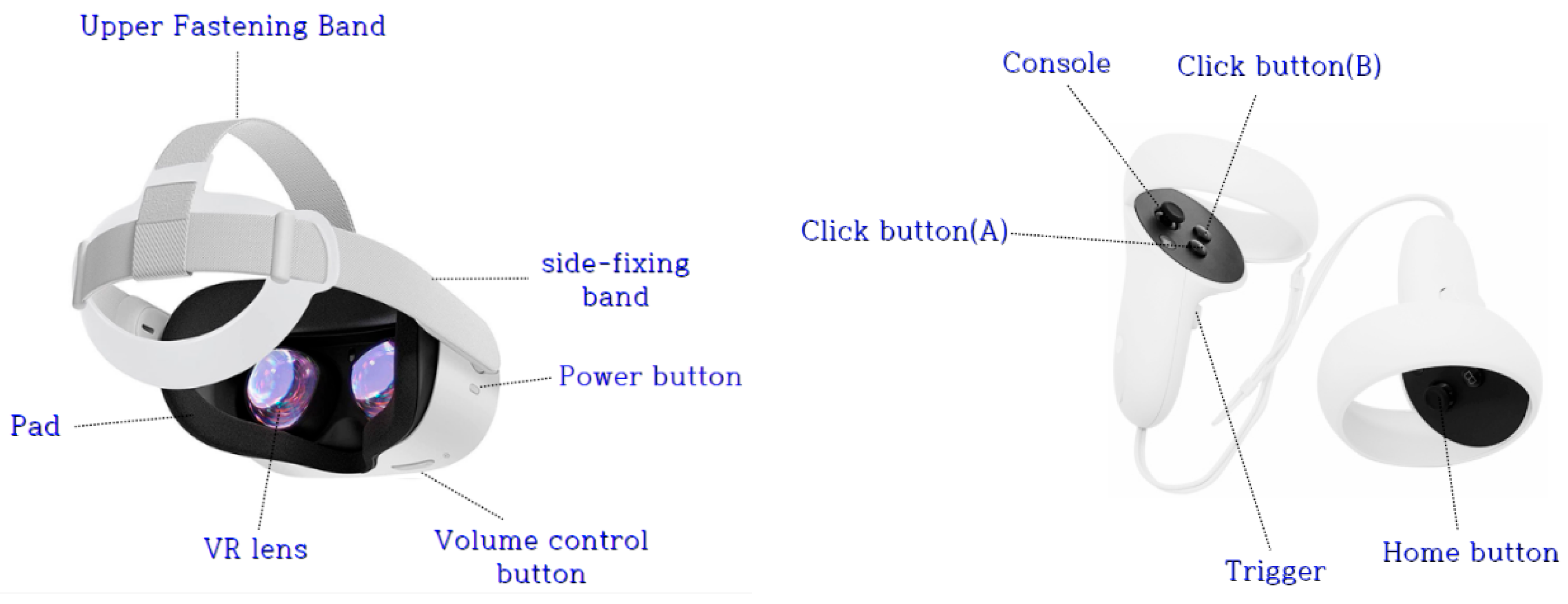
| Stage | Goals | Details |
|---|---|---|
| Adapting to Water | Becoming Friends with Water | Activities include getting wet, learning entry methods, walking and running in water, and holding breath underwater. |
| Breathing | Breathing Techniques | Activities for learning breathing methods underwater, including blowing air out through the nose and breathing exercises while holding onto the wall. |
| Floating for Survival | Floating in Water | Activities for learning various floating methods, including using equipment for survival floating and floating without equipment. |
| Diving | Diving | Activities include touching the bottom of the pool and turning underwater. |
| Maintaining Body Temperature | Body Temperature Maintenance Methods | Activities for learning various methods to maintain body temperature underwater, including wearing life jackets and activities for individual and group body temperature maintenance. |
| Moving | Moving | Activities for learning how to move in water, including moving with a life jacket and passing obstacles underwater. |
| Evaluating | Evaluating | Reviewing and evaluating the learned content. |
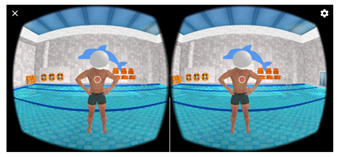 | 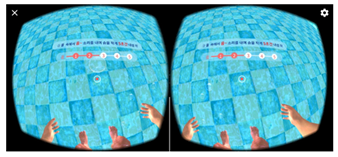 |
| Preparing for Swimming: Learning the Characteristics of Water Through an Understanding of Gravity and Buoyancy. | Floating Survival: Learning How to Float in Water with Minimal Energy Consumption. |
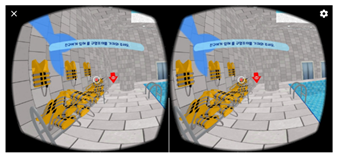 |  |
| Getting Acquainted with Life Jackets: Learning How to Wear Life Jackets Through VR. | Moving by Holding a Kickboard: Acquiring the Skill of Moving Using a Kickboard Through VR. |
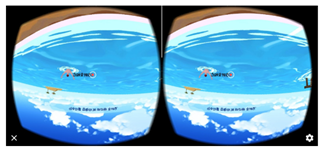 | 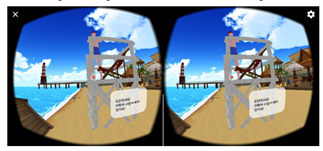 |
| Diving: Learning Diving Techniques Through VR. | Rescuing Using Various Objects: Acquiring Various Rescue Methods Through VR. |
| Participants | Gender | Experience | Characteristics |
|---|---|---|---|
| instructor A | female | 3 years 2 months | After retiring as a synchronized swimming athlete, worked as a swimming and water survival instructor at a swimming pool. |
| instructor B | male | 3 years 4 months | Holds a Water Survival Instructor certification and plans VR water survival content. |
| instructor C | male | 3 years 2 months | A major in Physical Education, developed a VR water survival instructional plan. |
| instructor D | female | 8 years 2 months | After retiring as a synchronized swimming athlete, worked as a swimming and water survival instructor at a swimming pool. |
| instructor E | male | 3 years 4 months | Developed a VR-based water survival instructional plan and conducted VR-based outreach water survival education primarily for schools. |
| instructor F | female | 3 years 3 months | Planned VR-based water survival content and conducted VR-based outreach water survival education primarily for schools. |
| instructor G | female | 6 years 3 months | Started a career in water safety in their early 20s, beginning as a lifeguard. |
| instructor H | male | 4 years 8 months | Holds a Water Survival Instructor certification and plans VR water survival content. |
| instructor I | male | 4 years 7 months | Developed a VR-based water survival instructional plan and conducted VR-based outreach water survival education primarily for schools. |
| instructor J | female | 8 years 3 months | Based on their experience as a swimmer during school days, they instruct swimming and water survival to students. |
| instructor K | male | 5 years | Planned VR-based survival swimming content and conducted mobile VR-based survival swimming education primarily for schools. |
| Technological Content Knowledge (TCK) | |
|---|---|
| Aspect | Details |
| Content Utilization | Use of media and instructional materials, adjusting learning content, motivation induction, utilizing VR content appropriate for learning objectives. |
| Equipment Preparation | Understanding educational media, preparedness for lessons, managing physical environment, preparing VR devices, conducting pre-checks. |
| Addressing Dizziness | Using supplementary materials, knowledge about learners, encouraging participation, utilizing 3D content and breaks for VR dizziness. |
| Pedagogical Content Knowledge (PCK) | |
| Aspect | Details |
| Creating a Learning Environment | Maintaining lesson direction, creating effective environments, managing lesson flow to maintain focus and prevent disturbances. |
| Enhancing Student Engagement | Encouraging questions and answers, knowledge of teaching strategies, fostering teacher–student relationships, using questions and games to simulate realistic environments. |
| Technological Pedagogical Knowledge (TPK) | |
| Aspect | Details |
| Setting Appropriate Learning Objectives and Guidelines | Subject knowledge, explanation skills, interconnections between contents, ensuring comprehension of VR session and content connectivity. |
| Educational Assessment | Knowledge about assessment, developing assessment plans and tools, using quizzes and feedback to reflect VR content and improve future lessons. |
| Understanding Learners | |
| Details | |
| Customizing learning experiences based on each learner’s prior knowledge, interests, and special requirements, adjusting teaching methods to learner levels. | |
| Pedagogical Beliefs and Philosophy | |
| Details | |
| Encouraging active learning, inquiry, and collaboration, fostering an inquiry-based environment, aiming for educational experiences that are enjoyable and memorable. | |
Disclaimer/Publisher’s Note: The statements, opinions and data contained in all publications are solely those of the individual author(s) and contributor(s) and not of MDPI and/or the editor(s). MDPI and/or the editor(s) disclaim responsibility for any injury to people or property resulting from any ideas, methods, instructions or products referred to in the content. |
© 2024 by the authors. Licensee MDPI, Basel, Switzerland. This article is an open access article distributed under the terms and conditions of the Creative Commons Attribution (CC BY) license (https://creativecommons.org/licenses/by/4.0/).
Share and Cite
Shin, Y.C.; Kim, C. Pedagogical Competence Analysis Based on the TPACK Model: Focus on VR-Based Survival Swimming Instructors. Educ. Sci. 2024, 14, 460. https://doi.org/10.3390/educsci14050460
Shin YC, Kim C. Pedagogical Competence Analysis Based on the TPACK Model: Focus on VR-Based Survival Swimming Instructors. Education Sciences. 2024; 14(5):460. https://doi.org/10.3390/educsci14050460
Chicago/Turabian StyleShin, Yoo Churl, and Chulwoo Kim. 2024. "Pedagogical Competence Analysis Based on the TPACK Model: Focus on VR-Based Survival Swimming Instructors" Education Sciences 14, no. 5: 460. https://doi.org/10.3390/educsci14050460
APA StyleShin, Y. C., & Kim, C. (2024). Pedagogical Competence Analysis Based on the TPACK Model: Focus on VR-Based Survival Swimming Instructors. Education Sciences, 14(5), 460. https://doi.org/10.3390/educsci14050460








